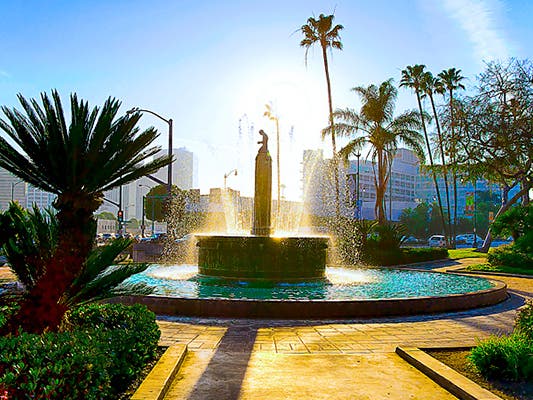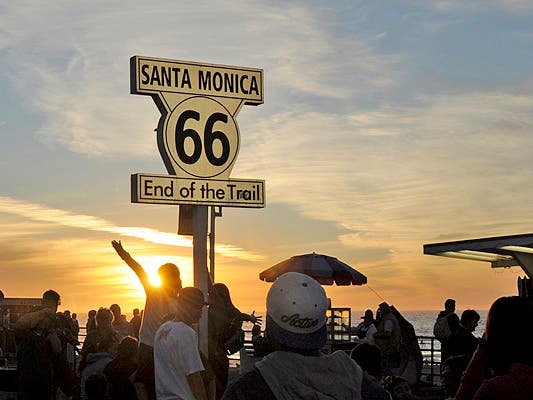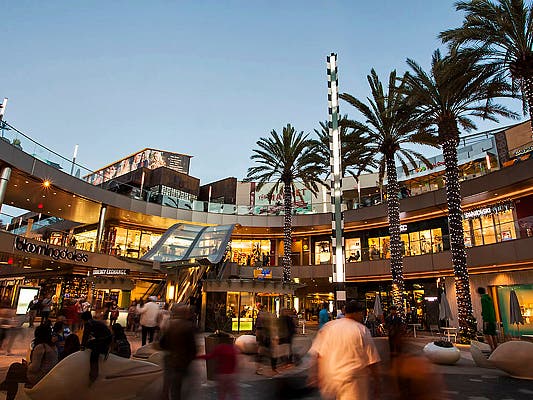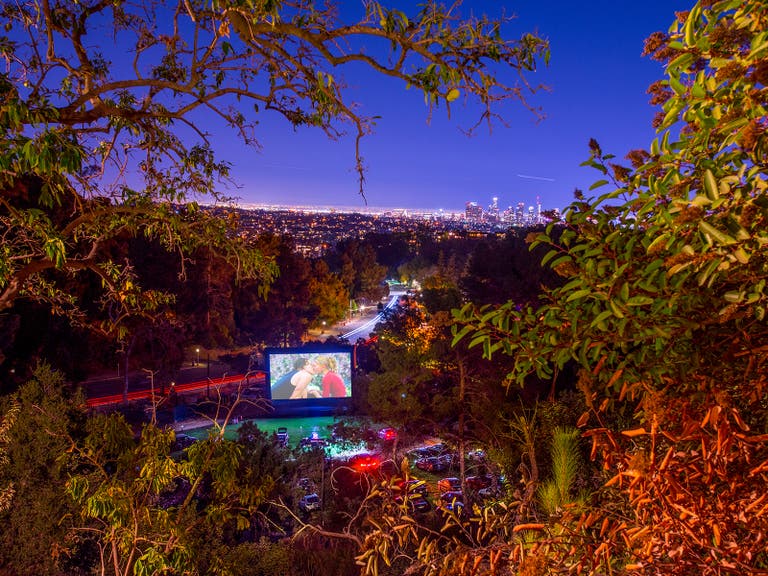Discover Beverly Hills & Santa Monica Car Free

This car free itinerary takes you on a budget-friendly tour of famous attractions and hidden gems in Beverly Hills and Santa Monica. From historic landmarks like the Electric Fountain and the Santa Monica Pier, to world-class shopping destinations like Rodeo Drive and Santa Monica Place, there's something for everyone on this car free tour.

Beverly Hills City Hall
The tour begins on the steps of Beverly Hills City Hall, at the Crescent Drive entrance. Designed by architect William Gage, the landmark Spanish Renaissance building opened in 1932 and has been featured in numerous films and TV shows, most famously in Eddie Murphy’s 1984 blockbuster, Beverly Hills Cop.
From City Hall, visit the Beverly Hills Farmers' Market, a weekly outdoor certified market that provides the finest California-grown, fresh and seasonal fruits and vegetables, juices, breads, specialty items and more. The market is located along Civic Center Drive between Third Street and Santa Monica Boulevard, and is open Sunday from 9:00 a.m. to 1:00 p.m., rain or shine.

Beverly Gardens Park
Open year round since 1911, Beverly Gardens Park stretches for 22 blocks along Santa Monica Boulevard. The 1.9-mile linear park features a jogging path, hundred-year-old cypress and ficus trees, gardens, public art, and the iconic Beverly Hills Sign, a 40-foot-long replica of the original historic sign that’s one of the most photographed spots in the city. The park is also home to the popular Beverly Hills Art Show, held during the third weekends in May and October.
O'Neill House
Continue west to the O’Neill House, a 1980s-era private residence located on Rodeo Drive just a few blocks north of Santa Monica Boulevard. The home of art dealer Don O’Neill and his wife, Sandy, has an Art Nouveau design inspired by the Spanish Catalan architect, Antoni Gaudí. The free-form structure, with its cascading mosaic roof, wave-like trim and rounded windows, is one of the most unique buildings in the city.
Spadena House aka The Witch's House
Next is the remarkable Spadena House, aka "The Witch’s House." Built in 1921, the private residence is located at the corner of Walden Drive and Carmelita Avenue. The Spadena House is considered the finest example of the Storybook style of architecture. It was designed by Harry Oliver, an Oscar-nominated art director and key figure in Storybook architecture. Fans of the 1995 sleeper hit, Clueless, will recognize the Spadena House from a scene when Cher (played by Alicia Silverstone) walks past it.

Electric Fountain
Located at the busy intersection of Wilshire and Santa Monica Boulevards, the famed Electric Fountain was erected in 1931 on the western end of Beverly Gardens Park. The fountain was designed by architect Ralph Carlin Flewelling. Atop the fountain is Robert Merrell Gage’s statue of a Native American kneeling in prayer. The Electric Fountain is named for the colorful lights and water jets that change every eight minutes.
From the Electric Fountain, board the Metro Rapid 720 and head to Santa Monica.

SANTA MONICA PIER & ROUTE 66 SIGN
Opened in 1909, the historic Santa Monica Pier is the site of restaurants, shops, an aquarium, a 1920s carousel, and Pacific Park, a family-friendly amusement park that includes a roller coaster and the world’s only solar-powered Ferris wheel. Every summer, the pier hosts the Twilight Concerts, one of LA’s most popular outdoor music series.
The Route 66 End of the Trail Sign is one of Santa Monica’s hidden gems, located on one end of the Santa Monica Pier. Known as the Will Rogers Highway, the Mother Road and the Main Street of America, the 2,450-mile-long Route 66 was originally built to connect Chicago to Los Angeles. Though the actual end of the legendary highway has been debated for decades, this replica of the long-lost End of the Trail Sign officially marks the Western terminus of the great highway.

Chess Park
Located near the volleyball courts at the Santa Monica Pier, International Chess Park is the site of chess matches played by locals and visitors alike. In the sidewalk is a life-size chess board, with permanent tables and chess boards nearby. Bring your own chess pieces and match wits with a friend, or watch the intensity of the games already going on. People-watching rarely gets more cerebral than this.

Original Muscle Beach
The original Muscle Beach dates back to the 1930s on the sands of Santa Monica Beach. With LA's temperate climate, the beachfront view and the influence of Hollywood, Muscle Beach became a destination for gymnasts, stunt people, wrestlers, acrobats and circus performers. When day-to-day maintenance became difficult, the gymnastics platform and weightlifting shed were bulldozed, the City of Santa Monica closed the area down in 1958, and the Venice Beach Recreation Center inherited the title. In 1989, the City of Santa Monica rededicated the original Muscle Beach, which is now primarily used by gymnasts, acrobats and youth.

Palisades Park
The 26-acre Palisades Park was donated to the city in 1892 by Santa Monica’s founders, Col. Robert Baker and Senator John P. Jones. Santa Monica’s largest park stretches 1.5 miles along Ocean Avenue, from Colorado Avenue to just north of San Vicente Boulevard. Walk along the cliffside and enjoy spectacular views of Santa Monica Bay from Malibu to the Palos Verdes Peninsula. The park features a Visitors Center kiosk, Camera Obscura, public art, picnic areas, benches, rose garden, and shuffleboard courts that are located outside a Senior Center.

Third Street Promenade
The Third Street Promenade is a popular shopping, dining and entertainment complex in downtown Santa Monica. The Promenade's roots date to the 1960s, when three blocks of Third Street were converted into a pedestrian mall. It then became known as the Santa Monica Mall in the 1970s before launching as the Third Street Promenade in 1989 after an extensive re-design. In addition to upscale retail chains and movie theatres, visitors can also enjoy street performers and a twice-weekly farmers’ market.

Santa Monica Place
Located at the south end of the Third Street Promenade, Santa Monica Place originally opened in 1980 and was designed by renowned architect Frank Gehry. A multi-million dollar renovation project removed the mall’s roof, added public walkways, created an indoor-outdoor dining deck, and introduced numerous upscale stores such as Tiffany & Co., Hugo Boss and Louis Vuitton. The new Santa Monica Place celebrated its grand re-opening in August 2010.
From Santa Monica Place, board the Metro Rapid 720 and head back to Beverly Hills.

Beverly Wilshire, A Four Seasons Hotel
Located just steps from Rodeo Drive, the Beverly Wilshire (A Four Seasons Hotel) has welcomed Hollywood legends and international VIPS - Elvis Presley, John Lennon, Warren Beatty, the Dalai Lama, the British royal family and the Aga Khan are just some of the hotel's famous guests. The Beverly Wilshire features 395 stylish guest rooms (including 137 luxury suites), Wolfgang Puck's CUT steakhouse and a world-class spa.
